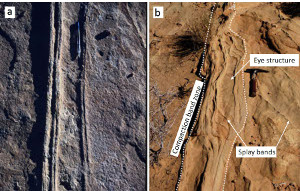| |||||||
|
|
|||||||
|
|
|||||||
| Compaction Band Zones | |||||||
|
Compaction bands which are composed of a number of closely-spaced, sub-parallel distinct individual bands are referred to as zones, also known as 'clusters.' Incipient band zones or clusters include a few bands formed next to each other (Figure 1a) suggesting that each band forms sequentially. Well-developed zones of compaction bands are generally more complicated (Torabi et al., 2015) and may also include bands at different orientation than that of the main set, which will be described under 'Splay Volumetric Bands' and 'Multiple Compaction Band Sets.' Compaction bands, particularly zones, are typically more resistant to weathering thus forming fins with prominent geomorphic features in the field. | |||||||
| Reference: |
|||||||
| Torabi, A., Aydin, A., Cilona, A., Jarsto, B.E., Deng, S., 2015 |
|||||||
|
Readme | About Us | Acknowledgement | How to Cite | Terms of Use | Ⓒ Rock Fracture Knowledgebase |
|||||||
